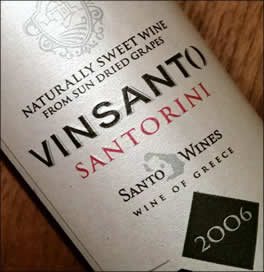Vinsanto 2006 from Santo Wines - A Fabulous Sweet Wine from Greece
Santorini is a Greek island in the Aegean Sea about 120 miles southeast of mainland Greece. It is a venerable wine region with a long history of producing quality wines that dates back centuries. While it produces some respected white and red wines it is probably best known for a sweet dessert-style wine known as Vinsanto.
It’s worth pointing out that Vinsanto is spelled as one word in order to differentiate it from the famous Tuscan sweet wine known as “Vin Santo”. While the two wines are similar in some regards they differ in that they are made with different grape varieties and utilize different procedures for drying the grapes.
There are also important stylistic differences between the two. The Vin Santo from Italy can range from bone dry to ultra-sweet depending on the type of wine a producer desires as determined by the grapes’ sugar level before fermentation. By way of comparison, producers of Vinsanto on Santorini are bound by regulations that govern all aspects of production such as alcohol levels and vinification and ageing protocols. If it says Vinsanto on the label, you can be reasonably sure of what you're getting.
The name Vinsanto itself documents its special relationship with Greece and the island of Santorini i.e., Vinsanto is derived from vino-santo or “wine of Santorini.”
Assyrtiko (ahs sert tee' ko) is the dominant grape variety used in producing Vinsanto. It is Santorini’s most prominent and prized grape variety. The white Assyrtiko grape produces structured, full-bodied wines with high acidity and prominent flavors. It is also one of those rare white varietals from the Mediterranean basin capable of producing wines with good ageing potential. The Assyrtiko grapes’ naturally high acidity can keep the wine fresh for decades and enables the wine to develop amazing richness and complexity.
Regulations require that Vinsanto must consist of no less than 51 percent Assyrtiko with the remainder consisting of Aidani, another native white grape variety. Many producers include higher-than-required proportions of Assyrtiko in their Vinsanto wines.
Traditionally, Vinsanto is made in the Passito style, that is from late-harvest grapes that are dried in direct sun light for one to two weeks, then crushed and fermented with a minimum 9% of alcohol. The regulations also require that the wine be aged for a minimum of 24 months in oak barrels before being bottled
As a result of the long oak ageing regimen Vinsanto wines typically develop a blood-orange red to amber color and a complex potpourri of dried fruit, raisin, and sweet spice aromas and flavors. They also typically have a full, intense sweet taste balanced by Assyrtiko’s benchmark acidity.
Founded in 1947, Santo Wines - more formally known as the Union of Santorini Cooperatives - is a cooperative organization with approximately 1,200 active members, the largest on the island. Its members are committed to producing quality wines using local, traditional practices while promoting sustainable agricultural practices and respect for the environment.
The 2006 Vinsanto from Santo Wines consists of 85 percent Assyrtiko and 15 percent Aidani grapes. The late-harvest grapes are sun-dried for 7 days. The drying process causes the grapes to lose water and shrivel which concentrates the grapes’ natural sugars. The grapes are gently pressed, fermented in stainless steel and then aged in oak barrels for 3 years, one year more than the minimum requirement.
This is a captivating and intense, well-made wine. It has a copper-amber approaching dark brown color. With its complex assortment of aromas ranging from sweet kitchen spices like cinnamon and ground ginger to walnuts and dried fruits like raisins and figs it reminds me of an aged sweet sherry. This Vinsanto is a viscous beauty with a velvety, full-bodied mouthfeel and enlivening flavors of dried figs, molasses and honey topped off with a complex, aromatic finish. A streak of essential acidity nicely balances this medley of flavors and keeps it from tasting too syrupy or heavy.
This is a wine to be savored by itself or served with simple, not-too-sweet desserts such as flavorful cheeses, nut-filled pastries or perhaps a classic Greek custard-fruit torte.
Santo Wines’ Vinsanto normally retails for $30 for a 500 ml bottle - that is when you can find it. It’s hard to find in the U.S. and if you can’t find it your best bet may be to ask your favorite wine shop if they can special-order some for you. Better yet, pick up a bottle or two on your next trip to Greece or elsewhere in Europe.
©Richard Marcis
September 15, 2016
For other reviews of award-winning wines and their producers see Italian Wines.
Help keep this website ad-free and independent.
Consider making a contribution to support the work of WineWordsWisdom.com.


